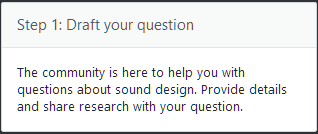TL;DR To help stem the tide of bad/off-topic Q's, we need your suggestions for help text
displayed in the right pane when asking a question (see this post and related sister post).
Yes, we need YOUR thinker to give us words! How important do YOU feel now? Your words could be a permanent fixture on our site! Helping swathes of confused users stumbling in the dark! Your shimmering words lighting up the path, slowly but definitively spelling out your immortal words… "JOG ON, YOU'RE NOT WELCOME HERE" …or, you know, whatever you want it to say. There are no "wrong" answers, I suppose.
ENOUGH! To business...
Given the recent tidal-wave of off-topic questions asking things like "how do I pick my teeth with my 1/8" headphone jack?", it's about time we customized these snippets of guidance that adorn the question asking process. These helpful chunks of information are the same for all SE communities, but can be customized if needed, as many other communities have done. The right help text at the right moment will help quell the tide in a clear, tight and informative way.
There are TWO such help text displays we can customize:
1. The "Asking a good question" modal. (which we're discussing in a sister meta post)
2. The "Step 1: Draft your question" right-panel help pane(which we're discussing right here ↓)
The "Step 1: Draft your question" pane…
What is the "Step 1: Draft your question" help pane?
This help pane displays to the right or under the question textbox when writing a question. It's the same for all sites, but we do have the option of changing some of the text to make it more in-line with our site-specific guidelines. (if you want to see the help pane - just click "ask a question" as I did above)
What can we change?
Please read this answer, it explains things way better than I ever could!
Read it? Good… So in summary, we can change the whole paragraph and can even add HTML (lists, links, etc) - refer back to the answer you just read for links to real world examples from other communities.
Why does it need to change?
We are getting a lot of questions where the user doesn't seem to have read or understood what is on-topic and what isn't. We get questions about home theatre, consumer stuff like mobile apps and questions asking how to do something on a particular device which can be found easily in the manual or with a quick Google search. So we need to add more explicit guidelines in the help text. Hopefully the user will read it before they post.
Some real-life DATA to hone your sword against:
Closed Questions
I encourage you to spend some time scrolling through this list of closed questions to get an idea of what close reasons pop up regularly and what could be said to these users to collectively nip these questions in the bud.
Bad Questions
In addition, it would be helpful to scroll through this list of questions with a negative score to get an idea of bad questions, and what could be said to these users to help improve their questions.
Finally…
Please read this post mentioned earlier before submitting any suggestions, it's extremely informative on the subject and the process and includes successful examples from other communities.
Answers
You can give full answers, or you can just suggest points you think should be included or sentences or paragraphs to consider.
The community answer can be updated with any popular suggestions.
You can even vote to not change the "Step 1: Draft your question" pane if you wish. If there is already a "don't change it" answer, just upvote and give your reasoning in a comment.
I'll start the ball rolling with the community wiki answer - this is where we'll mould the suggestions to a complete answer. Feel free to add your own complete answer, though - it will be just as valid.
Timescale
If we get support for a particular layout after a month, we'll pass it to the CMs for review.
This is your chance to help mould our site into a better repository of knowledge for the world of sound design and production!




